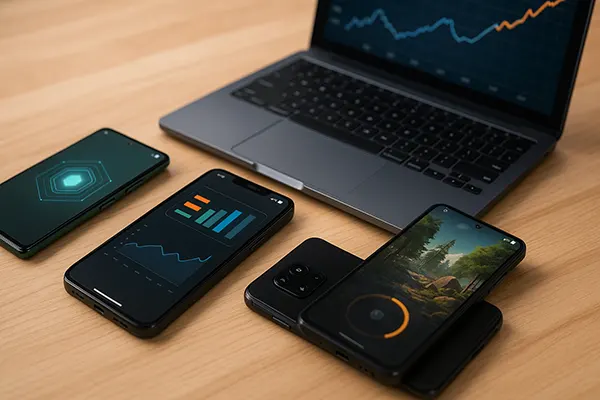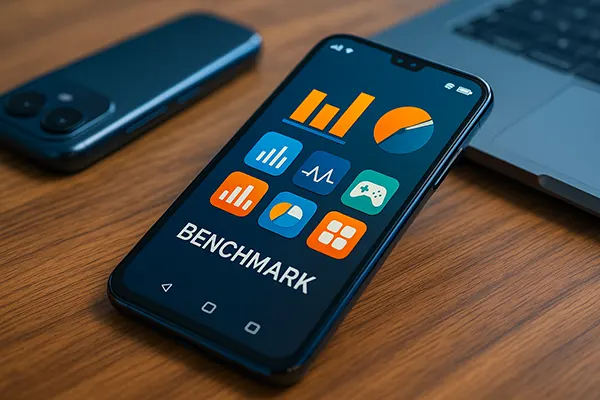Smartphones in 2025 are more powerful than ever, yet users still need reliable ways to evaluate their performance. Benchmark tools provide measurable data about processor speed, graphics capability, memory management, and overall system efficiency. Understanding how to interpret benchmark scores helps determine the true potential of a device beyond marketing promises.
1. Geekbench 6: Comprehensive Cross-Platform Performance Testing
Geekbench 6 remains one of the most trusted benchmark tools in 2025 for both Android and iOS users. It measures CPU and GPU performance using real-world workloads such as photo editing, machine learning, and document compression. The tool offers single-core and multi-core results, allowing users to compare devices fairly across operating systems.
Since the introduction of version 6.3, Geekbench has refined its testing algorithms to reflect modern computing demands. Tasks like AI-powered image processing and multi-threaded rendering now play a larger role in score calculation. This means that the results are more accurate for evaluating devices designed for heavy multitasking or gaming.
When interpreting Geekbench results, focus on the multi-core score if you often run complex applications. However, a high single-core score indicates faster everyday performance such as web browsing or social media use. Comparing scores between models gives a realistic view of efficiency, regardless of manufacturer claims.
Interpreting Geekbench Scores Effectively
A score difference of 10–15% between devices in the same price range may not result in a noticeable difference in daily use. Look at trends instead of isolated numbers. Consistency across multiple test runs suggests stable performance and efficient thermal management, both of which are essential for sustained usage.
Users should also check whether their device is running in performance or battery-saving mode during the test. Benchmark results can vary significantly depending on settings and background activity. Always repeat tests after rebooting and ensuring no apps are consuming system resources.
For developers, Geekbench data can serve as an indicator of hardware capability for optimising software. It highlights how well CPUs manage simultaneous tasks and how GPU resources are distributed across demanding processes like gaming and 3D rendering.
2. 3DMark Wild Life: The Ultimate GPU Benchmark
3DMark Wild Life by UL Solutions is the standard for testing graphics performance on smartphones. It simulates intensive gaming environments using the Vulkan and Metal APIs to evaluate rendering speed and stability. Both Android and iOS versions of 3DMark offer comparable workloads, ensuring fair comparisons between flagship devices from different brands.
In 2025, the updated Wild Life Extreme benchmark supports ray tracing on select chipsets such as Qualcomm Snapdragon 8 Gen 3 and Apple A17 Pro. This addition provides a more realistic measure of next-generation gaming performance, especially for users interested in console-level graphics on mobile devices.
The app also includes a stress test mode that evaluates thermal throttling. Continuous looping tests reveal how well a phone maintains frame rates during prolonged gaming sessions — a crucial factor for gamers who demand consistent performance.
How to Read 3DMark Results
The most important metric is the average frame rate (FPS). A higher FPS indicates smoother gameplay, but sustained performance is what truly matters. If the stability percentage is below 70%, it means the device struggles with heat dissipation under extended load.
Comparing the “Best Loop” and “Lowest Loop” results helps identify how performance drops over time. A smaller difference between them indicates better cooling design. Many 2025 flagships, including Samsung Galaxy S24 Ultra and iPhone 15 Pro, achieve stability rates above 85%, showing significant progress in thermal control.
Always interpret GPU benchmarks in context. High scores are meaningful only if your typical use involves gaming, video editing, or AR applications. For everyday users, battery life and sustained efficiency are often more important than peak graphics output.

3. AnTuTu Benchmark: All-in-One Device Evaluation
AnTuTu remains one of the most popular all-purpose benchmarking tools available for Android and iOS. It analyses CPU, GPU, memory, storage, and user interface performance, providing an overall score that summarises device capability. The 2025 version, AnTuTu v10, introduces improved testing algorithms for foldable devices and AI-driven tasks.
Unlike synthetic CPU-only tests, AnTuTu gives a holistic overview by combining several components into one score. This makes it ideal for consumers who want a single reference point to compare phones. The database updates daily, featuring thousands of models and real-world test averages from users worldwide.
However, AnTuTu scores can vary based on firmware and optimisation. Some manufacturers have been known to boost performance during tests, though this practice is less common now due to stricter verification protocols introduced in 2024. The app now validates each test online to prevent manipulation.
Analysing AnTuTu Scores in 2025
When reviewing results, focus on the breakdown of categories instead of just the total score. A high memory score indicates faster app switching, while a strong GPU result benefits gaming. The UX (user experience) section shows how responsive the interface feels during multitasking.
It’s also advisable to compare your device to the same model with different configurations, such as RAM or storage options. This helps you understand how hardware variations influence results. For instance, LPDDR5X memory and UFS 4.0 storage provide a noticeable improvement over previous generations.
AnTuTu is best used as a comparative guide, not an absolute measure of quality. It’s valuable for spotting performance bottlenecks or confirming whether your phone performs as expected after updates or resets.



